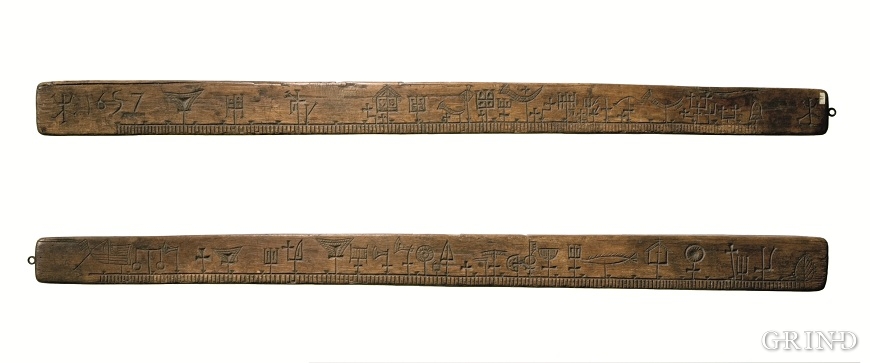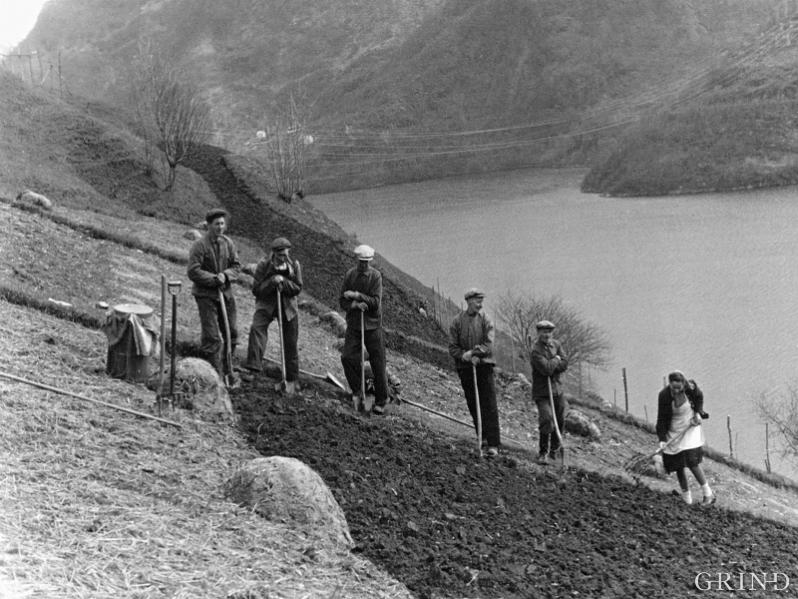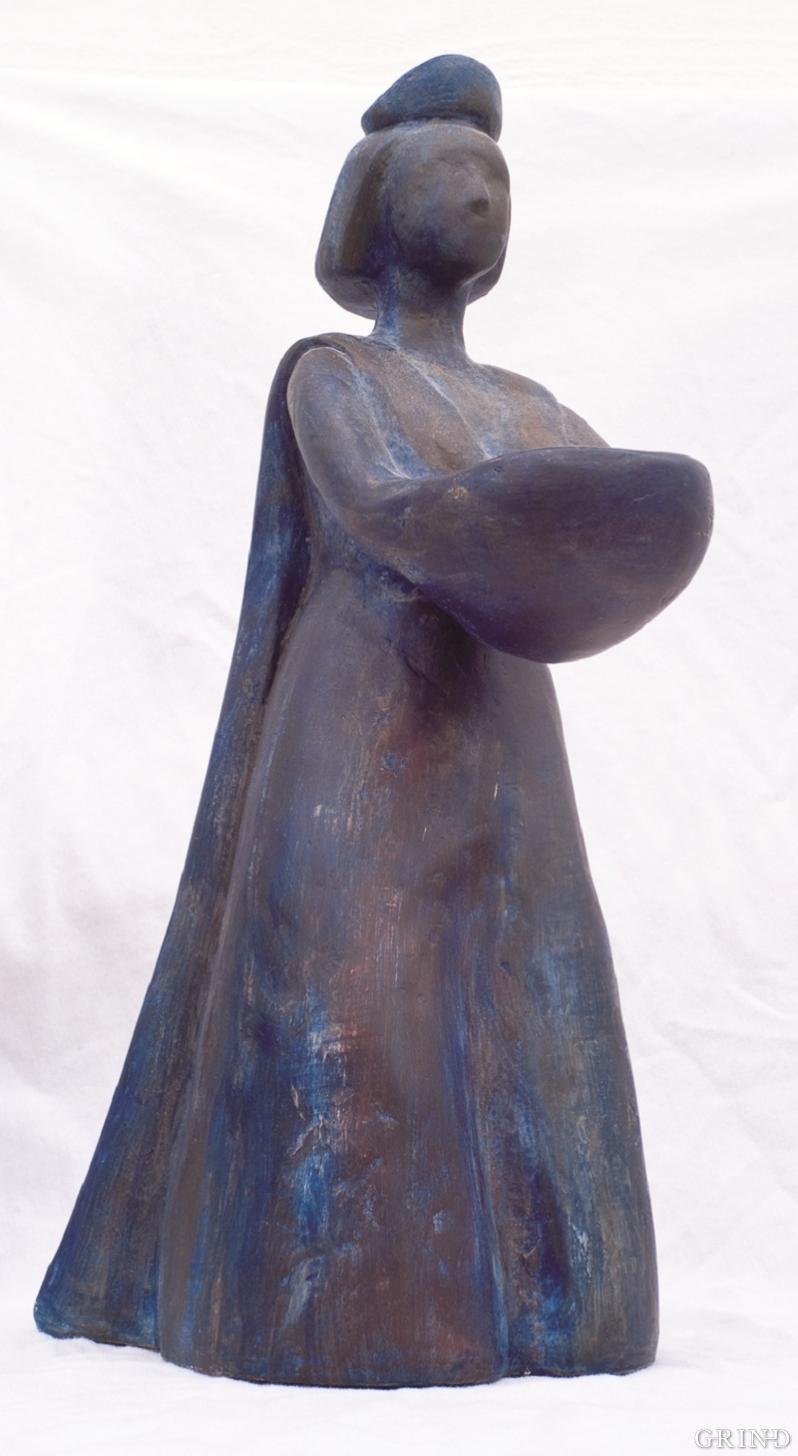Published: 19.05.2009 | Author: Brynjulf Alver
Primstav frå Tveit i Kvinnherad, datert 1657 (Svein Skare, eigar: Universitetsmuseet i Bergen (Bd 10)).
The old Norwegian farmers’ calendar, the wooden calendar staff, follows the Norse system of reckoning time, and divides the year into a summer half, and a winter half. The summer half begins on the 14th April and is usually signified by a deciduous tree. In Hordaland County this was the “spade day”; it was then that one could put a spade into the cornfields on the warmest slopes. The first winter day of 14 October is signified by a glove, now we are moving towards colder times. Some of the signs on the wooden calendar are “popular” ones, a drinking horn for Christmas indicates that now we have to follow the old tradition and drink in Christmas, a sun for Midsummer’s Day signifies that the sun is at its highest point. But the great majority are signs from the Church calendar. As the names of feast days they are linked to the saints the days are named after. All the Norwegian wooden calendars have a grinding stone at the 15th May as a reminder that Hallvard was drowned with a grinding stone round his neck. An axe on 29 July St.Olav’s Day is Olav’s axe. Many of the signs have been re-interpreted in the tradition and been linked to work and development. Close to the wooden calendar tradition we find weather signs and annual signs which were important in the old farming society.
The traditional wooden calendar staff
The first syllable: “prim” in the word “primstav” (or wooden calendar staff) probably comes from the Latin word “prima” meaning a key number which helped in establishing when Easter was in that year. Another name which has come up in discussion is “rimstav” where “rim” in Old Norse means time-reckoning. This could well be the case since Norwegian wooden calendar staffs never usually have key numbers.
The wooden calendar staffs from Hordaland County are all shaped as a board, 80 to 100 centimetres long and 5 to 6 centimetres wide. As is usual on Norwegian wooden calendar staffs, the calendar is divided into two, one on each side of the board; divided into a winter side from 14 October to 13 April, and a summer side from 14 April to 13 October. On the lowest part of the surface, short strokes are inscribed for each day. Some staffs are divided up for each seventh stroke so that it is possible to see which day it is if one knows the Sunday letter for the whole year. We find a figure on the surface of the staff for each feast day. These can be crosses or half-crosses, but can also have something to do with the churches or the legends of the saints. St.Laurentius Day on 10th August is marked by a grill because St.Laurentius was burned to death on a grill. All Saints’ Day on 1st November is usually marked by a ship, the symbol of the Christian church. St.Olav’s Day has Olav’s broad axe which was the symbol of our national saint. St.Hallvard’s Day on 15th May has a millstone, as St.Hallvard was drowned with a millstone round his neck.
Some signs have no connection with the church. This is true of the beginning of the summer on 14 April which almost always has a tree with leaves which signifies that this is the beginning of the summer half of the year. Similarly the beginning of winter is symbolised by a glove. Now we have to put on clothes again now that winter is coming. But also the two most important feast days of the year are marked by profane signs. Midsummer on 25th June often has a sun because it is the summer solstice. Christmas Day has a drinking horn, because now “we shall celebrate Christmas by drinking”. In connection with the celebration of Christmas we often find a barrel or a malt barrel for St.Thomas’ Day that is 21st December, a day which signifies brewing of beer. A memory perhaps of a cuckoo month in prehistoric times can be the sign of a bird on Cuckoo Day which was 1st May. From the life of work we find the scythe and the rake as signs for the period from 8th to 12th July and a millstone symbolises Egidius or the spirit of the mill on 1st September. After that they waited on the milling water. But often original Christian symbols were re-interpreted. The ship on All Saints’ Day on 1st November was a sign that now ship’s traffic would be taking a winter holiday. The axes on the Brøremesse (the two saints were beheaded) was interpreted as a sign that the wood for tools had to be cut. St.Batholomew’s Day on 24th August has lost all recollection that St.Bartholomew was beheaded and skinned alive. The knife was a sign that all the rams should be slaughtered.
The church calendar
In Chapter 15 in the section on baptism in the Gulating Law it is stated that each priest in his district where divine service is held, will send round crosses before the saints’ days and make sure they come to all corners of the district. Each man shall carry his cross to the next man, and will be responsible for ensuring that the crosses do not stop anywhere and that they will reach every hamlet.
To keep a track of the saints’ days the priest had their calendars. Some of the saints’ days concerned the congregation of the church, and others were only special days for the priests. Besides Christmas and the days around Easter, there were about 40 “major” church days. All of these were important days of celebration in popular marking of the passage of time.
The farmers also got their own calendar and we call that the farmers’ wooden calendar. We have every reason to believe that from the beginning it was a calendar for mass days. The oldest Norwegian wooden calendar that we know of is from 1457. It has probably been a calendar in the ownership of a priest, because it has Sunday lettering and golden numbers for working out when Easter falls. In farming society the religious function of the calendar was almost forgotten. The Mass days’ calendar was a feast days’ calendar, the summer half of the year was marked on one side, the winter half on the other.
The summer and winter halves of the year
That the year was divided in two in Norway must be an old tradition. This division of the year also followed the first pioneers to Iceland and has also been extended to neighbouring countries in the east. April 14 is the first day of summer and October 14 is often known as the “winter night” (the first night of winter). It could be said of a child: “He was born three weeks into summer”.
In our own times we operate with four seasons, that is winter, spring, summer and autumn and have more or less fixed dates for these four seasons. It was not like this before. Spring and autumn were only concepts/names which followed the growth of the year . But in any event they were divided into four in connection with the division into two. Midwinter was January 12 and midsummer was July 14. Another division into four was related to the four greatest church feast days with fixed dates, that is Christmas, Mary’s Spring Festival, Midsummer’s Day and Michaelmas. They reckoned with 13 weeks each in the first two quarters, 14 weeks in the third quarter and 12 weeks in the fourth. In Hamre these periods are called quarter-years even although they recognised that they were not of equal length.
Here with us the Latin months were “book months” as they were known in Iceland, and the old Norwegian names of the months are perhaps something that most people were not aware of. But right up to our own times the time after Christmas has been reckoned in “moon” months. The first was the Christmas moon, the moon month in which the thirtieth day occurred. There are still people in western Norway who go by the following moon-months Torre and Gjø, as well as Einar the single month.
In the summer months it was the working seasons which were dominant in dividing up the seasons: the digging/ploughing season, the intermediate period, the peat-making season, the hay-making season, the cutting season, the harvesting season, the potato harvesting season and the aftergrass season.
“Midsummer and the light mass”
It is the special feast days which have lasted longest in the Norwegian tradition of marking the passage of time. It is also these which have been the most important for daily life. Everything was measured in terms of feast days, that is so many days before or after this or that feast day; when cows were to calve and sheep were to lamb, when folk were born and when they died, agreements in business and many other things.
The feast days largely get their names from the Catholic church calendar, so that they coincided with the names of the saints’ days. It is easy to see the juxtapositioning with “day”, “mass” or “watch”; the twentieth day, the Light Mass, Midsummer’s Day. The word “voke” or watch is often abbreviated to “ok” in Hordaland and linguistically it goes back to the Latin word “vigila”; a night watch with prayer which the priests held the night before great church feast days. But also in popular festivities we hear that the sounds of the feast lasted all night, Midsummer’s Eve. In this case the festivities began the night before because the night belonged to the following day. Thus it is also in our own times it Midsummer’s Eve, 23 June and the night which follows it which are the great popular feast-days, although Midsummer’s Day is on the day after.
Those who gave their names to the days are first and foremost the Virgin Mary, the apostles and the Catholic saints. Only two of these are Norwegian, St.Olav with two days for St.Olav on 29 and 30 July and St.Hallvard on 15 May. A few feast days originally have Norwegian names, the first day of summer half of the year and the first day of winter, half of the year as well as Christmas (Yule) and some days linked to working life. The feast days were also the basis for working out the weeks which split the year up into smaller portions. In Masfjorden they were reckoned as follows: from Christmas to the Light Mass: 5 weeks and on to Gregor’s Mass a further 6 weeks, then to the first day of summer 5 weeks, and then 10 weeks to Midsummer, 5 weeks to St.Olav’s Day, to St.Bartholomew’s Day 4 weeks, to Michaelmass 5 weeks, to All-Saints’ Day 4 weeks and to Christmas 8 weeks. They reckoned in the same way at Voss but after St.Olav’s Day they had two weeks to St.Laurentius Day (10 August), two weeks to St.Batholomew’s Day, 3 weeks to Holy Rood Day in the autumn, and two weeks to Michaelmass. Almost every rural area had its own way of reckoning.
Feast days and working life
The feast days belong in a farming society. It is a farming society which is largely a self-contained subsistence one where crops and animals are of greatest interest. One ought not to have any expectations beyond the first year and there are remarkably few events which can be termed as “long term”.
The majority of events correspond to local experience. None of the rules allow for individual opinions; it is collective opinions which are generally accepted, in the local society that people have lived in. They give the “right time” for seasons and all types of work, tell us whether we can a expect a good or a bad harvest and tell us what sort of weather we have to expect. Some feast days intervene to regulate relations between neighbours, and for example, lay down times for when gates should be open or shut, when animals should be received or handed back, and when cattle should be moved to or from the mountain pastures. Other feast days were “moving” days for servants, and others were semi-holy days when it was forbidden to work.
But the dominant ones, nonetheless, were related to the likelihood or the apprehension for crops and livestock, and here of course the weather was the most important. As early as Paul the Apostle’s Day on 25 January people began to think ahead about the spring season and the summer. The longing for spring and new growth grew steadily greater, the longer one progressed through the winter. In the tradition connected to St.Peter’s Chair on 22 February and Mathew’s Mass on 24 February interest grew for the ice and snow which would soon disappear. Now they were past the worst. On Gregorsmass on the 12 March people could see that the days were lighter and the spring was approaching. The hay was diminishing in the hay loft and people gave thought to the hay harvest in the coming summer. At the Equinox on 21 March people could start working in the fields in the earliest rural areas of West Norway, but often people had to wait. At the Virgin Mary’s Mess on 25 March, winter had its last throw, but it is not yet summer. In the weeks to come, the feast day tradition emphasised that everything needed its time. If there was a sign of spring one should still not hurry too much. Winter “could take its revenge” as people used to say. Even if everything was pointing to an early spring, snow and ice could still come before one had time for reflection.
But by the beginning of the summer on 14 April it could be reckoned that the winter was over. Now the work in the fields could begin in earnest. The cattle should be born and bred, and even if it was too early to release the cattle for grazing, the focus was on sowing times and on moving cattle to the pastures, with St.Hallvard’s Day on 15 May being the most important day. In July they observed the weather for the coming harvest and for the haymaking. In the low country in Hordaland County the haymaking began on 10 July: “King Knut, chase the farmer with his scythe out”. After midsummer there was great anxiety about the weather for the haymaking. If there was rain on the worst rain days viz. Mary the Rain Queen on 20 July, Jakob Wet Hat, 25 July, Anna 26 July and the Seven Sleepers’ Day on 27 July, then it would be difficult to save the dry hay.
From St.Olav’s Day on 29 July thoughts turned to the harvest and to autumn weather, and people began to look for night frost. Important days were Peder’s Prison and St.Laurentius Day, 1st August and 10th August respectively. If the signs were good then you could have good expectations. On St.Bartholomew’s Day on 24th August the autumn slaughtering started; and the cattle came down from the mountain pastures to the home farm. The sheep had to be shorn and on Michaelmas, that is the 29th September the harvest was finished for the year and all the animals had to be on the home farm.
After the winter half of the year commenced on 14th October, thoughts turned to the tasks for the winter. Good days for signs for celebration were All Saints’ Day and St.Martin’s Day, that is 1st and 11th November respectively. By St.Katarina’s Day the 25th November the spinning wheels should be ready and the sheep would have to be mated. From St.Lucia’s Day, the 13th December thoughts were only directed towards Christmas. “From St.Lucia’s Night to Christmas every day is a feast day”, as the saying went. But the popular marking of time also contained many elements from a time when people had to manage without dates of the years, almanacs or clocks. They marked events in relation to local happenings: “it was still in the year before the great snow winter”, or “three years after Mother died”. They could know which day it was, by looking at where the sun was from a certain point on the ground. Such places were given names: Midday Peak, Sunset Cleft, Eleven O’Clock rise. They divided the day into spells of work. There was an old saying that the stomach was the best clock.
The old way of keeping track of time contained a rich culture. Much of what we have reckoned up until our days has its roots far back in pre-Christian times so that it is a very ancient culture we are dealing with.
- Alver, B. (1980) Dag og merke: folkeleg tidsrekning og merkedagstradisjon. 2. utg. Bergen.






